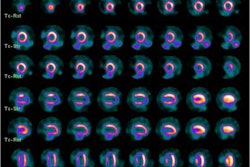Patients undergoing SPECT myocardial perfusion imaging (MPI) receive high cumulative radiation doses and often undergo repeat scans with the modality, concludes a study of more than 1,000 patients published online November 15 in the Journal of the American Medical Association.
When investigators added up all the imaging studies that delivered ionizing radiation over a 20-year period for each patient, they found that almost a third of them received more than 100 mSv, much of which was attributable to SPECT MPI, wrote study authors Andrew Einstein, MD, and colleagues from Columbia University Medical Center, New York-Presbyterian Hospital, and Staten Island University Hospital, all in New York City.
"Many patients undergoing nuclear stress tests over the course of their lives will undergo many procedures involving radiation and receive high cumulative doses of radiation, so I think it's incumbent upon physicians to develop better strategies to manage longitudinally the amount of radiation that patients receive," Einstein said in an interview with AuntMinnie.com. Einstein is director of cardiac CT research and associate professor of clinical medicine at Columbia.
Even though much of the recent focus on radiation dose reduction in medical imaging has been on cardiac CT scans, a previous study showed that the test with the highest radiation burden -- accounting for 22% of the cumulative effective dose from all medical sources -- is SPECT MPI, wrote Einstein and his colleagues in JAMA.
Use of the modality is rising: SPECT MPI volume increased from fewer than 3 million procedures annually in 1990 to more than 9.3 million in 2002, and it's now estimated to account for more than 10% of the cumulative effective dose from all sources except radiation therapy, the authors wrote.
Estimates of SPECT MPI doses per procedure can range from 10 to 25 mSv depending on the type of exam, but cumulative studies of radiation dose are rare and difficult to put together. In that respect, the facilities sharing data for the study benefited from good electronic health records spanning several regional facilities that allowed researchers to piece together a 20-year history of scans, according to Einstein. Still, it took three years to assemble almost 100% of the records for 1,057 patients, he said.
Still needed are careful studies of SPECT radiation doses to match the large amounts of information being produced in CT studies, and the still-growing use of ionizing radiation, Einstein added. In a 2009 report, the National Council on Radiation Protection and Measurements (NCRP) estimated that the per capita dose of medical radiation in the U.S. increased nearly sixfold between the early 1980s and 2006.
There have been few efforts to quantify these numbers at the patient level, however, and there is little data on radiation burden "over an extended time period by patients undergoing MPI, "many of whom present with symptoms, such as chest pain or dyspnea, that would predispose them to receive multiple tests involving ionizing radiation," the authors wrote.
The study analyzed procedures involving ionizing radiation received by 1,097 patients (51.5% women; mean age, 62.2 years) presenting for MPI to evaluate the total numbers of MPI examinations, other tests involving radiation, cumulative effective doses of radiation, and clinical indications for testing and repeat testing.
Over the study period, patients underwent a median of 15 (interquartile range [IQR], 6-32; mean, 23.9) procedures involving radiation exposure. These included a median of four high-dose procedures including a median of one (mean, 1.8) MPI study per patient.
Sixty-six percent of the MPI exams were dual-isotope scans, with their generally higher radiation profile of 20 to 25 mSv. Twenty-eight percent were thallium scans, 4% were single-injection technetium-99m studies, 1% were dual-injection technetium, and fewer than 1% were perfusion PET studies.
Over the 20-year study period, nearly one-fifth of patients (n = 200, 18.2%) had at least three MPI SPECT scans; 54 patents (4.9%) had at least five separate MPI exams, the group reported.
Administrative records were available for 99% of MPI examinations, they said. Previous procedures were identified for 996 patients (90.8%), dating back a median of 7.9 years before the index procedure.
In all, 344 patients (31.4%) received cumulative estimated effective radiation doses from all medical sources of more than 100 mSv. Multiple MPI exams were performed in 424 patients (38.6%), with a cumulative estimated effective dose of 121 mSv (IQR, 81-189; mean, 149 mSv).
Men and white patients had higher cumulative estimated effective doses. More than 80% of initial and 90% of repeat MPI examinations were performed in patients with known cardiac disease or symptoms consistent with it, the researchers wrote.
The median cumulative estimated effective dose from MPI alone was 28.9 mSv. For all medical testing combined it was 64.0 mSv. A total of 71 patients (6.5%) in the study received cumulative dosesof more than 100 mSv due to MPI alone.
In fact, 344 patients (31.4%) received cumulative estimated effective dose from all medical sources exceeding 100 mSv, including 120 patients (10.9%) who received cumulative dose of more than 200 mSv.
Increased cancer risk
"Our study reveals very high cumulative estimated effective doses to many patients undergoing MPI, and especially to patients undergoing repeat MPI testing," Einstein and his colleagues wrote of the results. "More than 30% of patients received a cumulative estimated effective dose of more than 100 mSv,a level at which there is little controversy over the potential for increased cancer risks."
The median cumulative estimated effective dose for the 39% of patients undergoing more than a single MPI exam was 121 mSv, "higher than that in the exposed (≥ 5 mSv) cohort in the Life Span Study of Japanese atomic bomb survivors," they added.
Nevertheless, it's easy to misread the population-based numbers in the study, which don't translate well to individuals with varying characteristics such as age and health status, the authors noted. For one thing, the older patients (average, 62 years) who underwent SPECT exams can be expected to suffer fewer ill effects than a younger population, and their shorter remaining lifespans would tend to mitigate any effect from increased radiation exposure in the population.
Einstein said he might reasonably speculate that the patients at his institution are more or less typical compared to those in other centers, though the single-center design was acknowledged as a study limitation. Overall, patients coming to Columbia might be just a little sicker than the norm, he said, but on the other hand there may be less financial incentive to push unnecessary tests at the academic facilities.
The data showed that more than 80% of initial MPIs and 90% of repeat MPI examinations were performed in patients with known cardiac disease or symptoms consistent with it, a sign that there may be room for tests besides MPI, according to Einstein.
"Two cornerstones of radiological protection are justification (ensuring expected benefit exceeds harm for each exposure) and optimization (keeping the likelihood of incurring exposure and magnitude of individual exposures as low as reasonably achievable)," they wrote. So even if individual MPI study is justified, "the cumulative radiation burden from all medical imaging and intervention procedures may not be optimized."
While MPI accounted for only 26% of cumulative radiation dose on average, appropriate use criteria do not yet simultaneously consider the appropriateness of other modalities that involve no ionizing radiation exposure, and only superficially address longitudinal management strategies, which have clear implications for both radiation dose and health care costs, they wrote.
"This draws attention to the fact that just because a patient undergoes one test at one time that may be appropriate, that's not to say that another test wouldn't be more appropriate that time, and over the long term we may want to develop more robust strategies so that the cumulative doses of radiation are managed better," Einstein told AuntMinnie.com.
For a patient having multiple normal nuclear stress tests, a subsequent test that does not involve ionizing radiation -- for example, a stress echocardiogram -- might be appropriate, he added.
Coronary CT angiography involves radiation but generally less than MPI, and if a patient with a normal CT returns with chest pain, the physician can be fairly confident that it's not coronary artery disease.
The results show that normal myocardial perfusion was seen in all 16 patients undergoing repeat MPI within a year for recurrent chest pain without prior evidence of ischemia or scarring, the authors wrote.
Future efforts need to focus not just on justifying individual tests, but on "optimizing and validating longitudinal imaging strategies to lower cumulative doses while ensuring performance of imaging needed for therapeutic decision-making," Einstein said. "If a patient is getting five normal nuclear stress tests, then something is not happening the way it should be."
CT gets more research, scrutiny
Even though SPECT MPI doses generally exceed those of cardiac CT, CT has received far more scrutiny in recent years -- partly because researchers have been far more active in CT, Einstein said.
The NCRP report issued last year also noted that CT produced 24% of all nonradiotherapy radiation in the analysis, versus 11% from nuclear cardiology, he said. So even though it was all CT versus nuclear cardiology, the CT figure got more attention.
"I think the literature on radiation doses from CT is much greater than the literature on nuclear stress testing," he said. Going forward, however, "it's important that we focus on dose reduction for myocardial perfusion as well."
It's important to note that there have been important advances in efforts to reduce nuclear medicine doses in the past couple of years, he said. For example, the higher-dose dual-isotope MPI that was the mainstay of imaging during the study period (62% of all exams) is now reserved only for very select patients, Einstein said.
Many patients can now be imaged at 1 mSv or less using stress-only MPI in conjunction with highly efficient gamma cameras employing cadmium zinc telluride digital detectors, and the recently developed methods are still being validated, he said.
"We've been able to perform nuclear stress testing for less than 1 mSv in some of our patients, but that's not typical, and that technology is not available to most patients in the U.S.," Einstein said.
"Just because we can reduce the dose to the patient doesn't mean we should," he said. "We don't want to impede the diagnostic performance of the test. We need to validate dose-reduction efforts under way in nuclear cardiology, but those efforts have been under way for longer in cardiac CT."
By Eric Barnes
AuntMinnie.com staff writer
November 22, 2010
Related Reading
Study updates dose estimates for rubidium-82 cardiac PET, October 8, 2010
Cardiac SPECT/CT fusion captures SNM's Image of the Year, June 6, 2006
Rubidium-based PET may finally get its due, February 23, 2006
Copyright © 2010 AuntMinnie.com



















